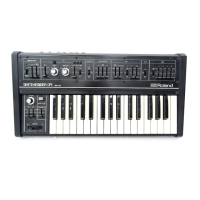Control
Options
The
creative control of
the SH-09
includes
Porta-
mento, LFO
Modulator, and
Bender
section
control
options. These controls are
simple
to
operate,
yet
add
much
to the
expressive
control
of
the syn-
thesizer in performance. Return
all
controls
to the
basic patch and proceed to explore
these
controls.
16
Portamento
Portamento is
a
slide
from one pitch to another,
much
as a
tronbone
might. The Portamento control
determines
the
time
required to change
pitches
when different keys
are pressed.
The
Portamento
slider is found directly
to the
left of
the keyboard,
and is
actually a
function
of the Keyboard Control
Voltage and its
control of
pitch.
Set the slider
at
"0'
and the
keyboard
will react
to
the
keyboard with instant pitch changes.
As the
slider
is raised, new keys pressed will slider
from
the last
pitch to the
new one, taking
longer
as
the
control is
raised further. If
you
strike
the same
key
twice in
a
row,
there will
be
no
slide since
Porta-
mento works
between
the
last
note struck
and
the
new one
—
in this
case
the
same note.
Portamento
stops
when
the
key
is released,
and is
best used
in melodic
situations
with
a quick
slide
that will allow the melody
to sound
clearly. Longer
portamentos are best used carefully
for
single
notes or
for effects
—
experience is your
best
guide.
Portamento may
be introduced
or
changed
at
any time
during performance,
adding variety
and
interest
Modulator
Section
The
Modulator
control section
is
located
at the
upper
left hand comer
of the SH-09
control
panel
and is
used
for
producing
regular
changes
in pitch
and
tone
such as vibrato, tremolo,
trills
and
effects.
The
Modulator section includes
a
Low
Frequency
Oscillator
(LFO) and
a
Sample
& Hold
circuit. The
output of
the Modulator
can be used
for
modulat-
ing
(changing) pitch through
the VCO,
tone
by
varying
the Pulse Width in the
VCO,
tone and/or
pitch within
the VCF, and for
repeated
gating
of
the
Envelope.
The
Modulator
Mode switch
determines
which
waveform will
be used
for VCO
and VCF
modula-
tion. The
three options include: f~\j
(sine wave),
nj
(square wave)
and Random
(S/H) for
the
Sample
and Hold
output
The Rate
slider
controls the frequency
or
speed of
change for
all Modulator
outputs.
Raising
the con-
trol
increases
the frequency,
which
may be
monitored
with
the associated flashing
LED.
Using
the
basic patch, experiment
with
the three
Modulator
Mode switch options
at various
rates
by
raising
the VCO and VCF
sliders singly
and
together in
various
amounts. The sine
wave
output
will give
smooth
pitch or tone
changes
usually
used for vibrato
and tremolo.
The
square wave
out-
put gives
steady, rhythmic
up/down pitch
and tone
changes
most commonly
used for trills
with
the
CVO.
The S/H
output
produces regular
rhythmic
changes
in
pitch or
tone of
a
random
depth. The S/H effect
is
a characteristic
of
synthesizers most
often
applied
as
VCF MOD
with
a
generous amount of
Resonance
—
this gives
a pronounced
effect with-
out disrupting
the identity
of pitches
being
played.
All three
Modes have
their
shape and rate
deter-
mined in
the
Modulator
section, their
application
and
depth determined
with
the VCO
and
VCF
MOD
sliders.
When
the
f~\j
Delay
Time
control
slider
is raised,
pressing
a key
on the
keyboard will
delay
the
effect of the
Modulator
sine
wave
output
on
the
VCO
and VCF.
This
Delay
follows
Keyboard Trigger
logic with
separated
notes having
delay, while
in
legato
playing
new
keys
depressed
to the left will
introduce
a new
delay
but
a new key
to the right
will
delay only
as keys
to
the left
are
released.
Raising
this slider
increases
the
delay
time, lower-
ing it fully
results in
a
continuous
output
with
no
delay
You
may wish
to
experiment
with
this func-
tion using
different
amounts
of VCO
and VCF
Modulation
and various
delay
lengths.
Notice
that
the
Delay control
has
no
effect on
the
Square
wave
and Random
S/H
outputs of
the
Modulator.
The
Modulator
has
a
smooth,
regular
output which
is
internally
wired
into
the
Pulse
Width
Modulation
section of
the
VCO
as
discussed
earlier.
This
out-
put
is not
effected
by the Delay
time
control or
the
Modulator
Mode
switch. LFO
Pulse
Width
Modula-
tion
usually uses
an LFO
rate
between
V
and
'3'
and
a moderate
amount
of
Pulse
Width
Modulation
depth. This
depth is
determined
by the Pulse
Width
slider
control
and
has
noticeably
more
effect
on
low
pitched
notes
than
on
high
notes,
so
set
your
patches
accordingly.
The LFO
within
the
Modulator
section may
also
be
used for
repeated
gating
of
the Envelope
section
as
described
earlier.
This
output
is
hardwired
to
the
Envelope
Mode
switch
and only
the
Modulator
Rate
control
and its
associated
LED
indicator
have
any
bearing
upon
it It
is useful
to note
that all
Modulator
section
outputs
including
VCO
and VCF
modulation
in
all three
modes,
Pulse
Width
Modul-
tion
and
repeated
Envelope
gating are
all
linked
to
the same
LFO
to allow
coordination
and
control
over
those
effects.

